BR(B → ρ/ω γ)/BR(B → K*γ)
In the case of penguin dominance, the ratio R = BR(B → ρ/ω γ)/BR(B → K*γ)
can be used to extract the ratio of CKM matrix elements |Vtd/Vts|,
adding a complementary information with respect to Δmd/Δms.
Anyhow, the method is affected by two sources of
theoretical uncertainties:
- The SU(3) breaking effect in the amplitude
- The presence of an annihilation contribution in B → ρ/ω γ
which is not present in B → K*γ decays and which
is associated to a different CKM factor (∼ V*ubVud)
One can use QCD factorization
to calculate the perturbative contribution to the amplitude.
A detail explanation of this method can be found in
hep-ph/0106067 and in
hep-ph/0106081. Most recent
analyses of B → V γ decays are available in
hep-ph/0405075,
hep-ph/0408231, and in
hep-ph/0412400.
In the framewrok of QCQ factorization,
the SU(3) breaking effect is taken into account by the ratio of B → V form
factors (which can be calculated using non perturbative techniques such as Lattice
QCD) and the remaining non perturbative contributions, suppressed by at least a
ΛQCD/mb factor, enters into the formula as a correction (ΔR) to the ratio R, written as
|
R = cρ2
|
rm
ξ2
|
|a7c(ργ)|2
|a7c(K*γ)|2
|
|Vtd|2
|Vts|2
|
(1 + ΔR)
|
where
- cρ is an isospin factor (1/sqrt(2) for ρ0γ and 1 for the others)
- a7c(Vγ) is the QCD factorization expression for B → V γ decay. We generate
the ratio a7c(ργ)/a7c(K*γ) according to a flat distribution in the range [0.99,1.03]
- ξ = FK*/Fρ is the ratio of B → V form factors. We take this quantity
as flat distributed in the range [1.09,1.26], as found in
hep-ph/0603232.
|
|
mB2- mρ2
mB2- mK*2
|
)3= 1.023
|
- ΔR is the correction coming from ΛQCD/mb terms
It is usually argued that, considering the present experimental precision, the effect
of ΔR can be neglected, using two different arguments:
- The effect comes from ΛQCD/mb annihilation contributions. Even if one can argue
that rescattering effects might occur in B+ → ρ+γ decays, one can restrict
the analysis to B0 → ρ0γ, where power suppressed terms are expected to be smaller
- ΔR is suppressed by a factor proportional to cosα, which is small
if one considers the Standard Model value of α
It is clear that the last argument introduces a non trivial circularity in the analysis
if one wants to use this bound to test the Standard Model.
Anyhow, it is interesting to quantify the impact of this bound on
ρ and
η.
We do it using neutral ρ0 γ decays on one side and
using the charged ρ+ γ decays on the other side
(taking experimental inputs from HFAG).
We prefer not to use the average of the (charged and neutral) ργ modes,
because the average looses any meaning if ΛQCD/mb
corrections are important. In fact, the decay amplitudes are not equal
and the increasing precision of the current experimental results does not
compensate any longer (in the previous analyses the experimental accuracy was such
that the average was taken as a good procedure, for example at the 2005 CKM workshop).
Considering the recent updates from
BaBar and
Belle on b → d γ decays
the world averages we use as input are:
| BR(B0→ K*0 γ) |
(40.1 ± 2.0) 10-6 |
BR(B+ → K*+γ) |
(40.3 ± 2.6) 10-6 |
| BR(B0→ ρ0γ) |
(0.91 ± 0.19) 10-6 |
BR(B+ → ρ+γ) |
(0.87 +0.27-0.25) 10-6 |
| BR(B0→ ω γ) |
(0.45+0.20-0.17)10-6 |
τB+/τB0 |
1.076 ± 0.008 |
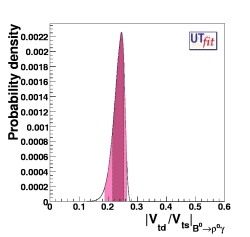
(EPS)
[JPG]
|
Output p.d.f. for |Vtd/Vts| from ρ0γ/K*γ
|Vtd/Vts| = 0.23 ± 0.02
[0.19,0.26] @ 95% Prob.
|
|
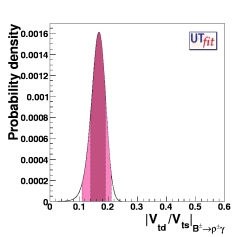
(EPS)
[JPG]
|
Output p.d.f. for |Vtd/Vts| from ρ±γ/K*γ
|Vtd/Vts| = 0.17 ± 0.03
[0.11,0.21] @ 95% Prob.
|
|
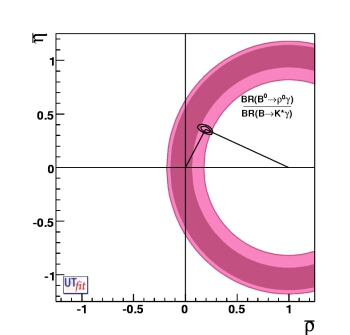
(EPS)
[JPG]
|
bound on (ρ;
η) plane
from |Vtd/Vts| (ρ0γ/K*γ)
|
|
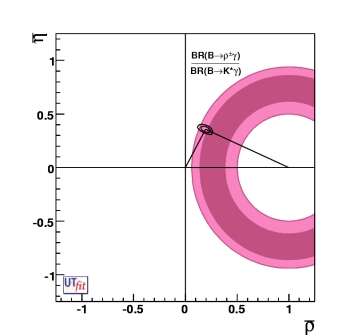
(EPS)
[JPG]
|
bound on (ρ;
η) plane
from |Vtd/Vts| (from ρ±γ/K*γ)
|
|
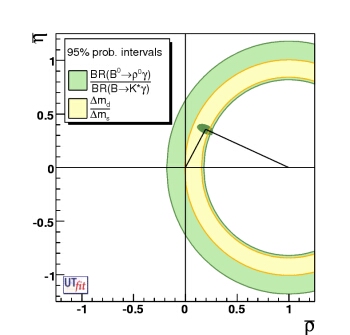
(EPS)
[JPG]
|
bound on (ρ;
η) plane
from |Vtd/Vts| (ρ0γ/K*γ) and Δms
|
|
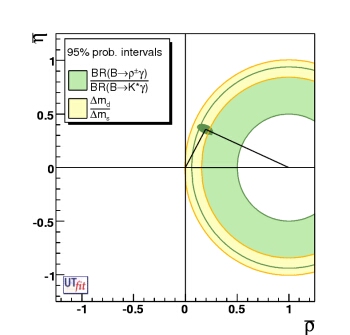
(EPS)
[JPG]
|
bound on (ρ;
η) plane
from |Vtd/Vts| (ρ±γ/K*γ) and Δms
|
|
It is even more interesting to compare it to the area selected from a (New Physics free) tree
level determination of ρ and
η coming from |Vub/Vcb|
and γ from B → D(*)K.
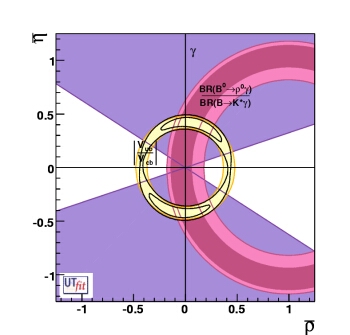
(EPS)
[JPG]
|
bound on (ρ;
η) plane
from |Vtd/Vts| (ρ0γ/K*γ) and |Vub/Vcb|
|
|
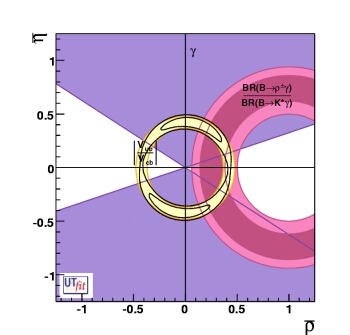
(EPS)
[JPG]
|
bound on (ρ;
η) plane
from |Vtd/Vts| (ρ±γ/K*γ) and |Vub/Vcb|
|
|
One can also revert the argument and use the Standard Model value of
|Vtd/Vts| to extract the value
of ΔR from the data.
The p.d.f of ΔR both from the ρ0γ and ρ± γ.
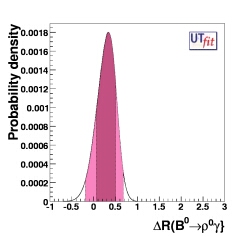
(EPS)
[JPG]
|
Output p.d.f. for ΔR from ρ0γ/K*γ
ΔR = 0.28 ± 0.22
[-0.19,0.69] @ 95% Prob.
|
|
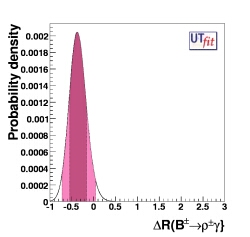
(EPS)
[JPG]
|
Output p.d.f. for ΔR from ρ±γ/K*γ
ΔR = -0.35 ± 0.20
[-0.72,0.05] @ 95% Prob.
|
|
An output value of R different than zero would indicate the enhancement of ΛQCD/mb
contributions and/or a problem in the evaluation of SU(3) breaking using non perturbative calculations.
Once these two points are clarified, one can think of using this bound for a search for
New Physics, since the present selected range shows an interesting disagreement. The present
situation is consistent with SM, so that the bound on ΔR is compatible with zero.
Acknowledgments
We would like to thank P. Ball, M. Beneke, J.Berryhill, W.D.Hulsbergen, L. Lellouch,
M. Misiak, and G. Sciolla for discussions and comments.
